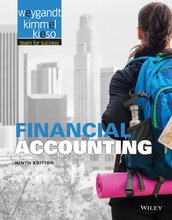Financial Accounting Weygandt 9th Edition Test Bank
$35.00 Original price was: $35.00.$26.50Current price is: $26.50.
Financial Accounting Weygandt 9th Edition Test Bank
Financial Accounting Weygandt 9th Edition Test Bank

Product details:
- ISBN-10 : 111833843X
- ISBN-13 : 978-1118338438
- Author: Jerry J. Weygandt
More students get accounting when using Weygandt’s Financial Accounting, Binder Ready Version 9th Edition because of the unique Framework of Success created and refined by the authors based on years of teaching and course design experience. The Team for Success is focused on helping millennial students get the most out of their accounting courses in the digital age, and on helping instructors deliver the most effective courses whether face-to-face, hybrid, or online with model course plans designed for easy and effective implementation. Financial Accounting, Binder Ready Version 9th Edition by Weygandt, Kimmel, Kieso provides students with a clear and comprehensive introduction to financial accounting that begins with the building blocks of the accounting cycle. WileyPLUS sold separately from text.
Table contents:
1 Introduction to Financial Statements 1-1
Knowing the Numbers: Columbia Sportswear Company 1-1
Business Organization and Accounting Information Uses 1-2
Forms of Business Organization 1-3
Users and Uses of Financial Information 1-3
Ethics in Financial Reporting 1-5
The Three Types of Business Activity 1-7
Financing Activities 1-7
Investing Activities 1-8
Operating Activities 1-8
The Four Financial Statements 1-9
Income Statement 1-10
Retained Earnings Statement 1-11
Balance Sheet 1-11
Statement of Cash Flows 1-12
Interrelationships of Statements 1-13
Other Elements of an Annual Report 1-16
A Look at IFRS 1-42
2 A Further Look at Financial Statements 2-1
Just Fooling Around?: The Motley Fool 2-2
The Classified Balance Sheet 2-3
Current Assets 2-3
Long-Term Investments 2-5
Property, Plant, and Equipment 2-5
Intangible Assets 2-5
Current Liabilities 2-7
Long-Term Liabilities 2-7
Stockholders’ Equity 2-7
Analyzing the Financial Statements Using Ratios 2-8
Ratio Analysis 2-8
Using the Income Statement 2-9
Using a Classified Balance Sheet 2-10
Using the Statement of Cash Flows 2-13
Financial Reporting Concepts 2-15
The Standard-Setting Environment 2-16
Qualities of Useful Information 2-16
Assumptions in Financial Reporting 2-17
Principles in Financial Reporting 2-18
Cost Constraint 2-19
A Look at IFRS 2-45
3 The Accounting Information System 3-1
Accidents Happen: MF Global Holdings Ltd 3-1
Using the Accounting Equation to Analyze Transactions 3-3
Accounting Transactions 3-3
Analyzing Transactions 3-4
Summary of Transactions 3-10
Accounts, Debits, and Credits 3-11
Debits and Credits 3-11
Debit and Credit Procedures 3-12
Stockholders’ Equity Relationships 3-15
Summary of Debit/Credit Rules 3-16
Using a Journal 3-17
The Recording Process 3-17
The Journal 3-18
The Ledger and Posting 3-20
The Ledger 3-20
Chart of Accounts 3-20
Posting 3-21
The Recording Process Illustrated 3-22
Summary Illustration of Journalizing and Posting 3-28
The Trial Balance 3-30
Limitations of a Trial Balance 3-31
A Look at IFRS 3-61
4 Accrual Accounting Concepts 4-1
Keeping Track of Groupons: Groupon 4-1
Accrual-Basis Accounting and Adjusting Entries 4-2
The Revenue Recognition Principle 4-3
The Expense Recognition Principle 4-4
Accrual versus Cash Basis of Accounting 4-5
The Need for Adjusting Entries 4-5
Types of Adjusting Entries 4-6
Adjusting Entries for Deferrals 4-7
Prepaid Expenses 4-7
Unearned Revenues 4-11
Adjusting Entries for Accruals 4-14
Accrued Revenues 4-14
Accrued Expenses 4-16
Summary of Basic Relationships 4-19
The Adjusted Trial Balance and Closing Entries 4-21
Preparing the Adjusted Trial Balance 4-21
Preparing Financial Statements 4-22
Quality of Earnings 4-23
Closing the Books 4-26
Summary of the Accounting Cycle 4-28
Appendix 4A: Using a Worksheet 4-33
A Look at IFRS 4-65
5 Merchandising Operations and the Multiple-Step Income Statement 5-1
Buy Now, Vote Later: REI 5-1
Merchandising Operations and Inventory Systems 5-3
Operating Cycles 5-3
Flow of Costs 5-4
Recording Purchases Under a Perpetual System 5-6
Freight Costs 5-8
Purchase Returns and Allowances 5-9
Purchase Discounts 5-9
Summary of Purchasing Transactions 5-10
Recording Sales Under a Perpetual System 5-11
Sales Returns and Allowances 5-12
Sales Discounts 5-13
Data Analytics and Credit Sales 5-14
Multiple-Step and Comprehensive Income Statements 5-15
Single-Step Income Statement 5-15
Multiple-Step Income Statement 5-16
Comprehensive Income Statement 5-19
Cost of Goods Sold Under a Periodic System 5-21
Gross Profit Rate and Profit Margin 5-22
Gross Profit Rate 5-22
Profit Margin 5-23
Appendix 5A: Periodic Inventory System 5-26
Recording Merchandise Transactions 5-26
Recording Purchases of Merchandise 5-27
Freight Costs 5-27
Recording Sales of Merchandise 5-27
Comparison of Entries—Perpetual vs. Periodic 5-28
Appendix 5B: Adjusting Entries for Credit Sales with Returns and Allowances 5-29
A Look at IFRS 5-54
6 Reporting and Analyzing Inventory 6-1
“Where Is That Spare Bulldozer Blade?”: Caterpillar 6-1
Classifying and Determining Inventory 6-2
Classifying Inventory 6-2
Determining Inventory Quantities 6-4
Inventory Methods and Financial Effects 6-6
Specific Identification 6-7
Cost Flow Assumptions 6-7
Financial Statement and Tax Eff ects of Cost Flow Methods 6-12
Using Inventory Cost Flow Methods Consistently 6-14
Inventory Presentation and Analysis 6-15
Presentation 6-15
Lower-of-Cost-or-Net Realizable Value 6-16
Analysis 6-16
Adjustments for LIFO Reserve 6-18
Appendix 6A: Inventory Cost Flow Methods in Perpetual Inventory Systems 6-21
First-In, First-Out (FIFO) 6-22
Last-In, First-Out (LIFO) 6-22
Average-Cost 6-23
Appendix 6B: Eff ects of Inventory Errors 6-23
Income Statement Eff ects 6-24
Balance Sheet Eff ects 6-25
A Look at IFRS 6-48
People also search:
Financial Accounting
Financial Accounting Weygandt Kieso Kimmel
Financial Accounting Weygandt Kieso Kimmel 9th
Financial Accounting Weygandt Kieso Kimmel 9th Test Bank
Financial Accounting Weygandt 9th Edition Test Bank
Related products
Test Bank
Test Bank for Clinical Immunology and Serology A Laboratory Perspective, 3rd Edition: Stevens











